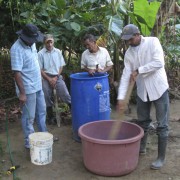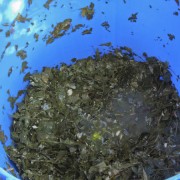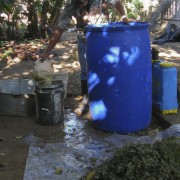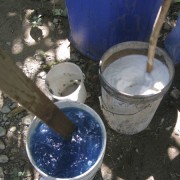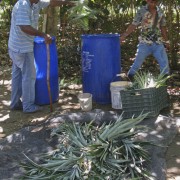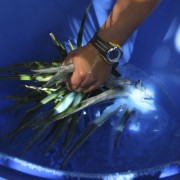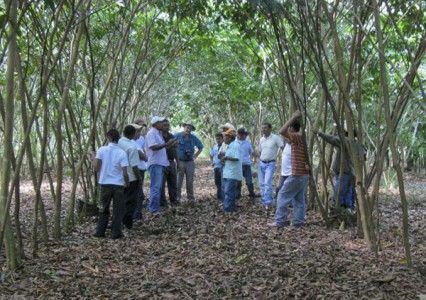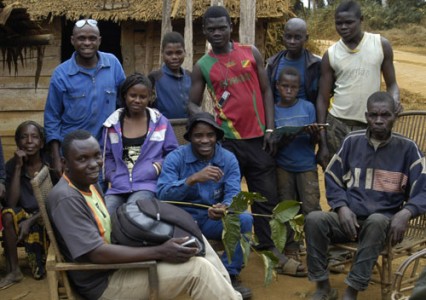Organic All The Way
After failing soil fertility, preventing the weeds from taking over is the biggest challenge to getting a good harvest for Honduran farmers using slash and burn. Repeated burning creates an environment that favours certain aggressive and fast growing grass species which are very hard to control. This problem has been worsened by the introduction of invasive grass species which are rapidly spreading across the country. It’s not surprising therefore, that many farmers use large quantities of herbicides in an attempt to say ahead of the weeds, potential harming the environment and contaminating local watercourses in the process. To make matters worse, limited information or understanding of the chemical products used can often lead to farmers applying doses far high than the recommendations. Also, most farmers have none of the recommended safety equipment and many of the families we work with report having fallen ill from chemical poisoning after spraying chemical products.
One of the key elements of the success of Inga alley cropping is its ability to completely control weed growth, eliminating any need to use herbicides and therefore protecting both farmers and their land from the harmfully effects these chemicals can have.
However, while herbicides are by far the most commonly used synthetic chemicals on Honduran farms, eliminating the need for herbicide use doesn’t automatically lead to organic farming. It’s a very good start but in order to make fully organic farming a viable option for local farmers, there’s another issue that needs to be addressed; pest control.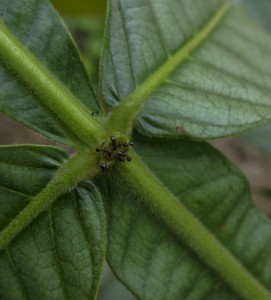
Here also, Inga alley cropping has an inherent advantage; Inga trees a have a symbiotic (i.e. mutually beneficial) relationship with ants which can help to keep some pest species under control. Inga trees secrete nectar from glands on their leaves. Ants love to feed on the nectar and, in return the ants kill many of the insect pests that would otherwise damage the Inga. Hence, in Inga alley cropping, the very high number of ants present can also help to protect the crops planted in the alleys. But while it’s a help, this alone isn’t enough to protect crops from attack by pest species, which will inevitably occur sooner or later.
When this happens, farmers will take whatever option available to them to save the harvests they depend on. If it comes down to a choice between letting the crop fail or using chemical pesticides, then for poor farming families that’s no real choice at all. Almost any farmers who can scrape together the money to do so will be reach for chemical pesticides, even though many say they would rather not because it’s more than they can really afford or because they fear for their health. What we want to do is add another choice to the list; crop failure, chemical pesticides or making your own cheap, safe and effective organic pesticides.
To that end, we’ve begun investigating different methods for creating organic pesticides. Every farmer within the project who we have mentioned this to so far has responded with enthusiasm, saying they would definitely be interested in learning how to make organic pesticides for themselves. The obvious motivator for this keen interest is money; conventional pesticides don’t come cheap and finding the money to buy them can be a real struggle for families. However, other motivations – not wishing to pollute their land or first-hand experience of adverse effects on their health are also quite commonly mentioned by farmers. Given this strong show of interest, we have redoubled our efforts to track down effective organic pesticides that can be made from cheap and easily available ingredients.
This week, on our Demo Farm, we tried out the first 2 organic pesticides we are hoping to share with farmers; one organic insecticide and one organic fungicide. We will observe closely the results of these 2 organic pesticides, and others than we plan to trial on our Demo Farm in the near future, in order to be sure of the effectiveness of each one before recommending them to local farmers.
- Mixing up organic pesticides on our Demo Farm
- Making an infusion of crushed neem and garlic
- Filtering neem/garlic extract
- Mixing coper sulphate and lime to make organic fungicide Caldo Bordeles
- Disinfecting pineapple plants with the organic pesticides before planting them out into the Inga alleys on our Demo Farm
- Disinfecting pineapple plants with the organic pesticides before planting
The organic fungicide we tried out this week is called Caldo Bordales, and is a relatively well-known organic pesticide which contains a mixture of two natural compounds; lime and copper sulphate, diluted to a concentration of 1%. Caldo Bordales is widely regarded as an effective fungicide and the ingredients required are cheap, making it a much more cost effective option than buying conventional pesticides.
The organic insecticide we made consisted of crushed neem leaves and crushed garlic diluted with water. Neem (Azadirachta indica) provides a remarkable organic insecticide which is affective against a several hundred different insect species. As most insects have to consume neem in order to be effected by it, neem generally leaves unharmed beneficial insects such as honey bees and spiders while targeting most herbivorous pest species. Plus, as the chemical structure of neem is so complex, scientists predict it will take a long time for pests to evolve any resistance against it. Garlic is also a useful ingredient in organic agriculture as it is strong repellent to a number of insect species. Other strong flavours like chili, lemon and basil can also serve as effective repellents against many insect pests and we hope to try these out in the near future.
In order to help us identify more plant species present in this region of the world that are known to have useful properties for the creation of organic pesticides, we have been in contact on the one of our key partner organisations, Kew Botanical Gardens. Kew have a huge knowledge base from which to draw on and we are hopeful that with their support we should be able to identify a variety of Central American plant species that farmers can grow on their own farms and use for the creation of organic pesticides.
To stay up to date with our progress as we push ahead with our search for the best organic options for farmers, keep an eye out for Facebook posts on this subject over the coming months.

